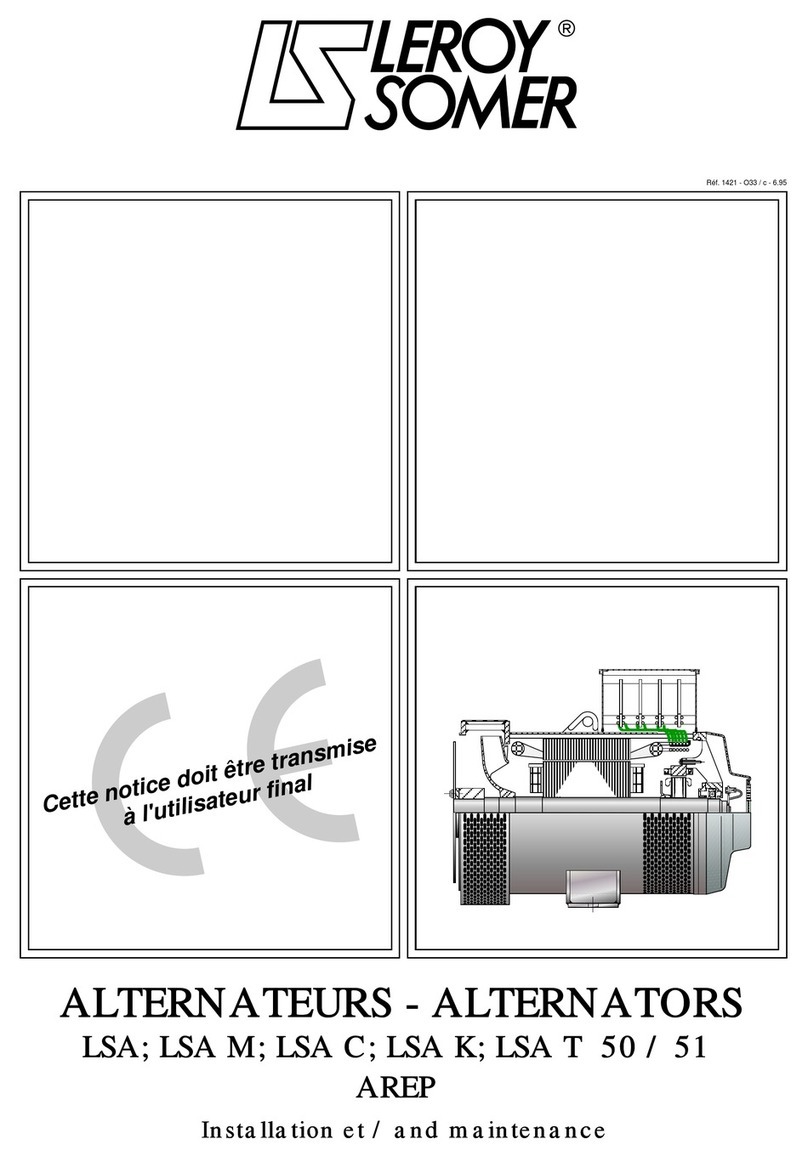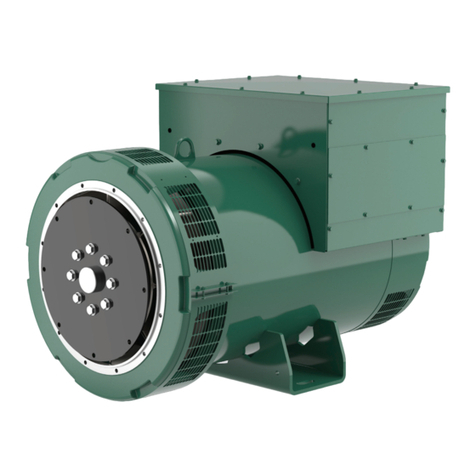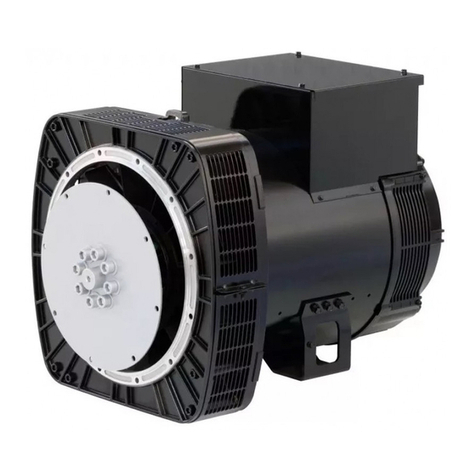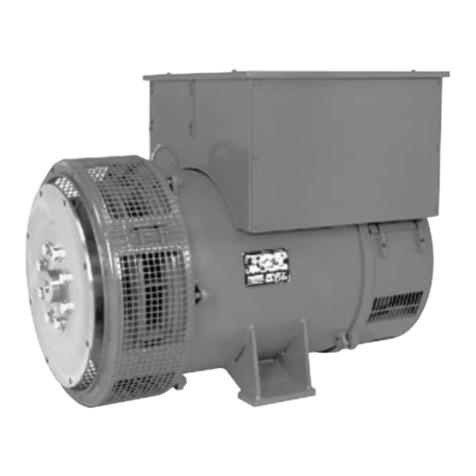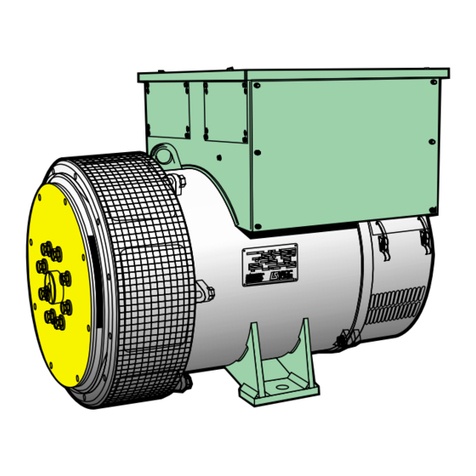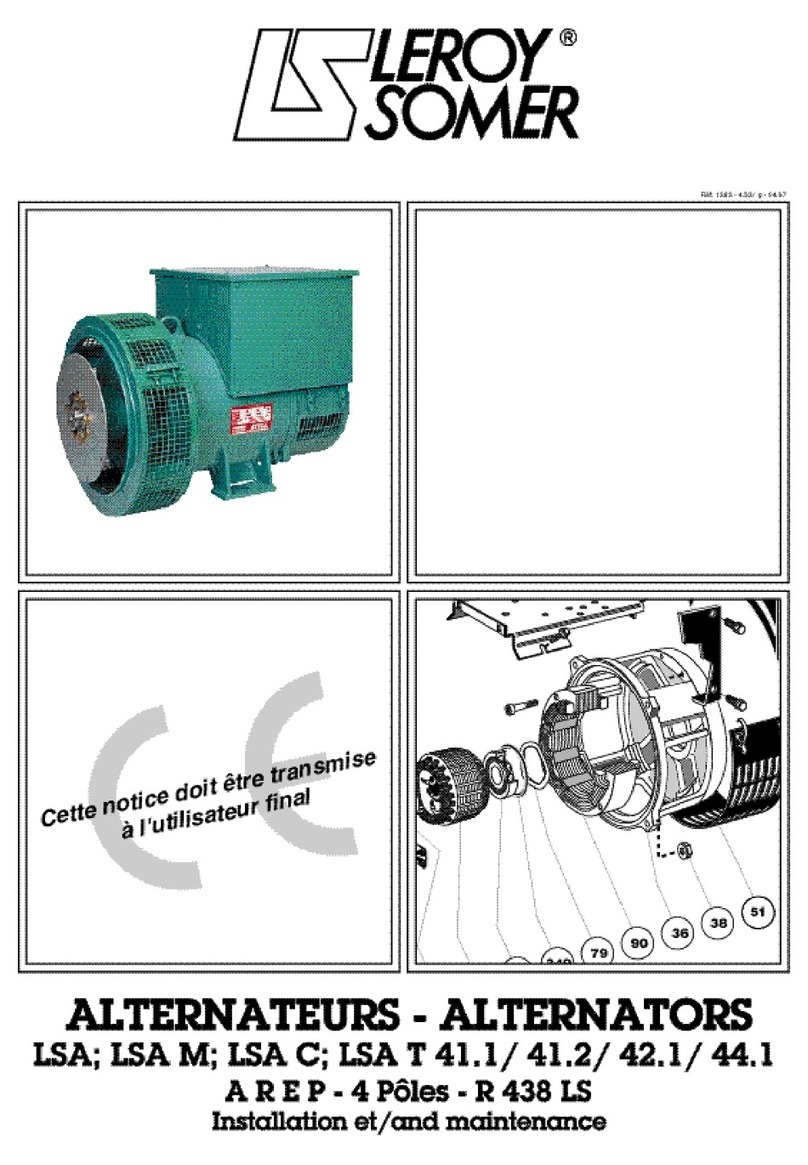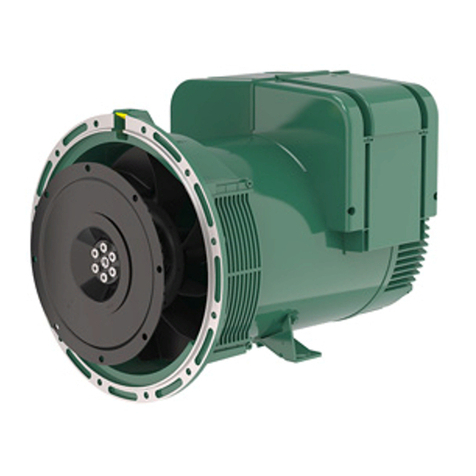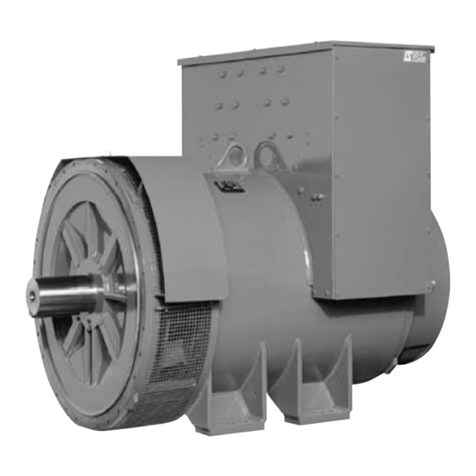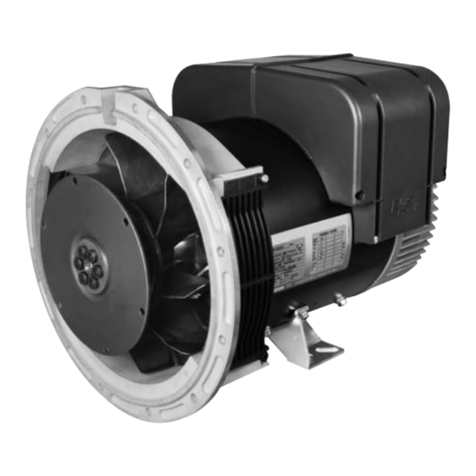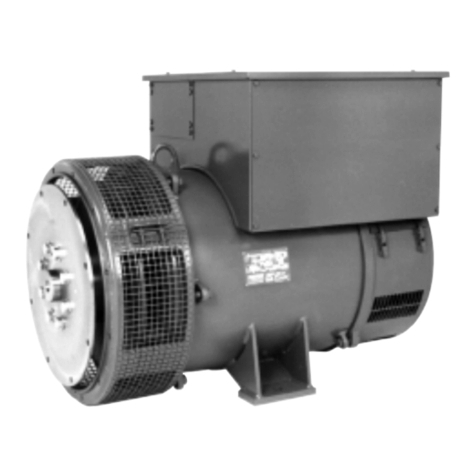
1 - GENERALITES
1.1 - Spécifications
Alternateursshuntautoexcitéssansbague,nibalaisavec
régulateur de tension.
Ils sont conformes à la plupart des normes internationales
compatibles avec les paragraphes concernés dans :
- les recommandations de la Commission
Electrotechnique Internationale CEI 34-1, (EN 60034).
- les recommandations de l'International Stan-
dard Organisation ISO 8528.
- la directive 89/336/CEE des Communautés
Européennes sur la Compatibilité Electromagnétique
(CEM) . - les directives des Communautés Européen-
nes 73/23/EEC et 93/68/EEC (Directive Basse Tension).
Caractéristiques électriques
- Isolation classe H
- Bobinage stator :pas 2/3 (2 pôles)ou plein pas (4 pôles)
- Capacitédesurcharge:lesalternateurssontcapablesde
faire démarrer des moteurs électriques dont le courant de
démarrage est égal à 1,8 fois le courant nominal de
l'alternateur .
- Régulationdetension:del'ordrede±1%enrégimeétabli
àlavitessenominalesurchargetriphaséenondéformante
équilibrée; sur charge monophasée ou déséquilibrée la
régulation de tension peut atteindre ±5%.
- Protection de sous vitesse incorporée (U/f)
- Amorçage automatique sur la tension rémanente
Caractéristiques mécaniques
- Carcasse en acier
- Flasques en fonte ou aluminium
- Roulements à billes graissés à vie
- Forme de construction standard :
B 34 (à pattes et bride de fixation à trous taraudés)
Bout d'arbre cylindrique normalisé.
MD 35 (monopalier à disque et bride d'accouplement)
- Machine ouverte, autoventilée
- Degré de protection : IP 21 (IP 23 sur demande)
(Alternateur en rotation)
Conditions normales de fonctionnement (machine
standard)
- Altitude inférieure à 1000 m
- Température ambiante inférieure à 40°C
- Facteur de puissance compris entre 0,8 AR et 1
Limite de fonctionnement dangereux
- Survitesse : 25 % pour 60 Hz
- Plage de réglage de la tension : ±5 %
- Surcharges (voir tableau de puissances)
1.2 - Principe de fonctionnement
L'alternateurestauto-excité,sansbaguenibalai,àexcita-
tion shunt avec régulateur de tension.
Lorsd'undémarrage, grâce aurémanentde l'excitatrice, il
se crée un courant dans l'induit de l'excitatrice (1). Ce
courant,redresséparlesdiodestournantes(2)alimentela
roue polaire (3). Celle-ci induit une tension
dans le bobinage stator de l'alternateur (4)
(tension de sortie). La tension induite dans
lebobinagealimenteàtraverslerégulateur
(6) l'inducteur de l'excitatrice (5). Le
régulateur de tension (6) contrôle le
courant d'excitation de l'excitatrice en
fonctionde la tension de sortie de l'alterna-
teur.
1 - GENERAL
1.1 - Specification
Brushless shunt alternators, self excited, self regula-
ted,supplied with voltage regulator.
Theycomply withmost of the international standardsfollo-
wing the relevants paragraphs of :
- the recommendations of the International
Electrotechnical Commission IEC 34-1 (EN 60034).
- the recommendations of the International
Standard Organisation ISO 8528.
- the directive 89/336/EEC of European Com-
munities concerning the Electro-Magnetic Compatibility
(EMC). - the directives 73/23/EEC and 93/68/EEC
concerning low voltage safety.
Electrical features
- Insulation class H
- 2/3 Pitch stator winding (2 pole) or Full Pitch (4 pole)
- Overload capacity : the alternator is able to start electric
motors,thestartingcurrentcanreachto1,8timestherated
current of the alternator.
- Steady state voltage regulation in the order of ±1% at
ratedspeedwhensupplyingnondistortingthreephaseba-
lanced loads. With single phase (or unbalanced) loads
voltage regulation is about ±5%.
- Built in underspeed protection (Volt per Hertz)
- Voltage build up based on residual magnetism.
Mechanical features
- Steel frame
- Cast iron end shields
- Sealed for life ball bearings
- Standard construction features :
Shape B34 (foot and flange mounted) cylindrical
normalized shaft end
MD 35 (Single bearing, flange and disc coupling)
- Screen protected / self ventilated
- Mechanical protection : IP 21 (IP 23 optional)
(Rotating)
Normal operating conditions (Standard machine)
- Altitude : less than 1000 m (3300 ft)
- Ambient temperature : less than 40°C
- Power factor : from 0,8 lagging up to unity.
Limit of dangerous operation
- Overspeed : 25% for 60 Hz
- Voltage adjustment : ±5 %
- Overloads : (see power table and curves)
1.2 - Principle of operation
Thealternatorisaselfexcitingbrushlessmachineof shunt
excitationdesign,selfregulatingbytheadditionorantrans-
istorised A.V.R.
When starting the residual magnetism creates a current in
the exciter armature(1). This current is rectified by the
rotating diodes (2) and feeds the main
field (3).The induced voltage is then
used to increase the excitation power
viathe AVR(6) tothe exciterfield (5)to
ensureafastandsmoothbuildupofthe
output voltage in the main stator
winding (4).
The sensing voltage for the AVR is
taken from the output leads.
3
Alternator
LSA 37 - ATR - 2 & 4 P
Alternateur
LSA 37 - ATR - 2 & 4 P
(2) (3)
(5)
(6)
(1)
(4)
